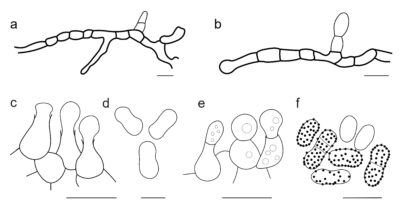Fungalpedia – Note 398, Lapidomyces
Lapidomyces de Hoog & Stielow
Citation when using this data: Tibpromma et al. 2024 (in prep.) – Fungalpedia, Rock-inhabiting fungi.
Index Fungorum, Facesoffungi, MycoBank, GenBank, Fig. 1
Classification: Incertae sedis, Capnodiales, Dothideomycetidae, Dothideomycetes, Pezizomycotina, Ascomycota, Fungi.
Lapidomyces was first established by Egidi et al. (2014) to accommodate L. hispanicus. Through multigene phylogenetic analysis, Egidi et al. (2014) identified Lapidomyces within Teratosphaeriaceae. Initially, the generic name Lapidomyces was considered invalid under Article 40.7 (Shenzhen) of the nomenclatural rules, as introduced by Egidi et al. (2014). This issue was later rectified by Crous et al. (2019), who published Lapidomyces as a valid established name. Lapidomyces has been described as a genus of sterile rock-inhabiting fungi that exhibit hyphomycetous characteristics (Egidi et al. 2014, Crous et al. 2019). Crous et al. (2021) expanded this genus by introducing two additional species isolated from Asphodelaceae and Poaceae. Both of these new species produced asexual morphs, one hyphomycetous and the other coelomycetous. The sexual morph of this species is unknown. Crous et al. (2023) introduced another new species to the genus, a hyphomycetous fungus isolated from a sooty mold community on Pinus nigra needles. Currently, the genus Lapidomyces comprises four species. All Lapidomyces species have been isolated from extremophilic habitats, including rocks in Spain, brown stems of Aloidendron dichotomum in South Africa, leaves of Stipagrostis cf. ciliata in Namibia, and a sooty mold community on Pinus nigra needles in Poland (Egidi et al. 2014, Crous et al. 2021, 2023).
Type species: Lapidomyces hispanicus G.S. de Hoog & B. Stielow
Other accepted species: Species Fungorum – search Lapidomyces
Figure 1 – Lapidomyces sp.. a, b Hyphae with short branches of L. hispanicus (CBS 118764). c Conidiogenous cells giving rise to conidia of L. epipinicola. d Conidia of L. epipinicola. e Conidiogenous cells giving rise to conidia L. stipagrostidicola (CBS H-24491). f Conidia of L. stipagrostidicola. Scale bars: a–f = 10 μm. Illustrated from Egidi et al. (2014), Crous et al. (2021, 2023).
References
Entry by
Wanasinghe DN, Center for Mountain Futures, Kunming Institute of Botany, Chinese Academy of Sciences, Honghe 654400, China.
(Edited by Saowaluck Tibpromma, Samaneh Chaharmiri-Dokhaharani, & Achala R. Rathnayaka)
Published online 26 November 2024
